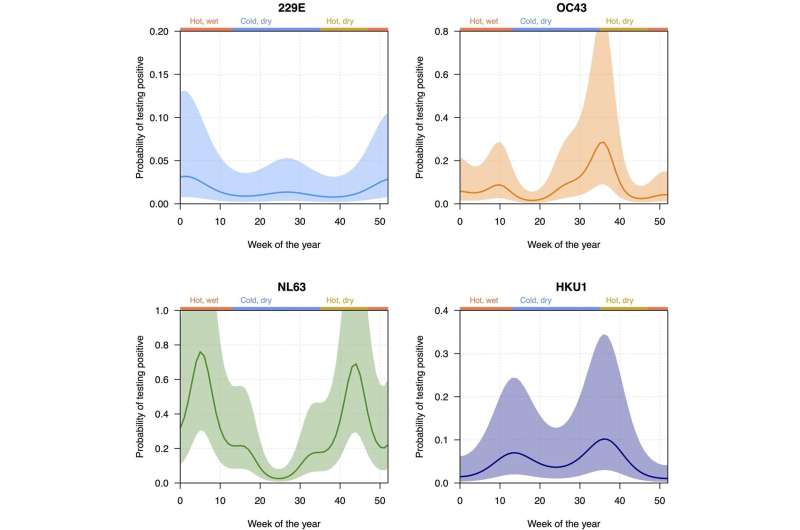This article has been reviewed according to Science X's editorial process and policies. Editors have highlighted the following attributes while ensuring the content's credibility:
fact-checked
trusted source
proofread
Common coronaviruses circulate twice yearly in Malawi, in contrast to annual winter peaks in more temperate climates

Common human coronaviruses circulate twice yearly in Malawi, in contrast to annual winter peaks in more temperate climates, according to new data.
The latest study, led by researchers at the MRC-University of Glasow Centre for Virus Research (CVR) and published in The Journal of Infectious Diseases, may shed some light as to how SARS-CoV-2, the virus responsible for the COVID-19 pandemic, may circulate in Southern Africa in future years.
Human seasonal coronaviruses—close relatives of SARS-CoV-2—typically cause mild flu-like illness, but can occasionally cause serious respiratory illness. Now, one of the largest studies provides insight into the circulation of seasonal coronaviruses in Africa—a region that often lacks epidemiological data on respiratory pathogens, especially those associated with non-severe disease.
Researchers examined the circulation of four species of common seasonal coronaviruses between 2011 and 2017 in Blantyre, Malawi, using PCR tests on nose and throat samples. They found that all four seasonal human coronaviruses peaked twice a year in Malawi, though the timing of the highest circulation differed across individual coronavirus species. This is in contrast to how they are known to circulate in temperate climates, such as the UK, America and Europe, where they tend to peak once a year, mostly in winter months.
The study included more than 6,000 samples from people of all ages. Those tested included people with both mild and severe acute respiratory illness, as well as asymptomatic individuals in the control group. Among adults, one of the circulating coronaviruses was associated with a mild illness, while two were associated with severe illness.
In children, all four human coronaviruses were equally likely to cause illness or an asymptomatic infection. Human coronaviruses were more frequently found together with other respiratory viruses (known as co-infections) in those with severe illness—compared to no or mild symptoms—and were also more common in children.
The study was the result of continued close collaboration between the University of Glasgow and the Malawi-Liverpool-Wellcome Trust Clinical Research Programme, and also involved researchers from Lancaster University, University of Liverpool, and the United States (US) Centers for Disease Control and Prevention (CDC).
Dr. Antonia Ho, lead author of the study from the CVR, said, "Very few studies have been done to understand how common human coronaviruses circulate in Africa and how much they contribute to respiratory illness. Our study is one of the largest and most comprehensive to date, spanning 7 years before the COVID-19 pandemic."
Understanding the circulation patterns of human seasonal coronaviruses may help us predict how SARS-CoV-2 may circulate in the future. We need to continue to monitor the circulation of human coronaviruses, including SARS-CoV-2, as well as other key respiratory viruses, such as influenza and respiratory syncytial virus.
Dr. Dory Kovacs, first author from the Univeresity of Glasgow commented "It has been a fantastic opportunity to collaborate with Dr. Ho, the Malawian team as well as researchers from Liverpool to shed light on the epidemiology of seasonal viruses in an under-studied geographical area."
More information: Antonia Ho et al, Epidemiology of human seasonal coronaviruses among people with mild and severe acute respiratory illness in Blantyre, Malawi 2011–2017, The Journal of Infectious Diseases (2023). DOI: 10.1093/infdis/jiad587. academic.oup.com/jid/advance-a … fdis/jiad587/7604038




















